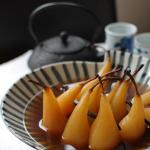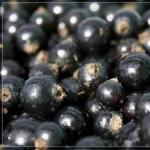Canned black currants without sugar for the winter. Canned blackcurrants without sugar How to preserve currants in their own juice
Black currant is considered one of the healthiest berries, including due to the high content of ascorbic acid in its composition. Vitamin C reacts poorly to exposure to high temperatures. When the berries are boiled, it is destroyed. Preparations whose preparation technology does not involve boiling the fruit are much more useful. These include black currants in their own juice, which even a novice housewife can prepare for the winter.
Cooking features
The process of preparing blackcurrants in their own juice has certain specifics and requires quite a lot of time, but it is not complicated. Even an inexperienced cook can successfully cope with the task if he knows and takes into account several points.
- Black currants must be thoroughly washed before cooking; this can be done in several waters, but it is advisable not to do this under a strong stream of water. Although currants are not a fragile berry, careless handling can lead to premature damage to the fruit and loss of some of the juice.
- After the currants are washed, you need to remove the branches from the berries and dry the fruits by pouring them onto a towel. If tap water gets into the product, it will make its taste less pleasant and will negatively affect the preservation of canned food.
- To prepare blackcurrants in their own juice, you can use only cleanly washed and sterilized jars. They are closed with metal lids to ensure tightness. Plastic lids are not suitable for this purpose. The lids also need to be sterilized; to do this, they are usually boiled for 5–10 minutes.
- The technology for preparing blackcurrants in their own juice is based on the release of juice by the berries when they are heated for a long time. Currants are sterilized in jars by placing them in a pan filled with water. You need to place a towel or silicone mat in the pan to prevent the jars from breaking. Heat the water in the pan over low heat. The water level should reach the hangers of the cans.
Black currants in their own juice can be prepared according to several recipes, including without added sugar. Sugar-free canned food is healthier and less caloric; it can be eaten by people suffering from diabetes. There is only one drawback to such preparations - they can only be stored in the refrigerator and for no more than 6 months. Canned food prepared with added sugar is stored in a cool place and does not spoil for at least 12 months.
Classic recipe for currants in their own juice with sugar
Composition (per 1 l):
- black currant – 1 kg;
- sugar – 0.35 kg.
Cooking method:
- Sort, wash the blackcurrants, remove the branches.
- Sterilize jars and matching lids.
- Pour the currants into jars, sprinkling each layer of berries with sugar.
- Cover with lids and leave for 2 hours at room temperature. During this time, the berries will release juice and settle.
- Add currants to the jars.
- Place a towel on the bottom of the pan and place jars of currants on it.
- Pour water into the pan so that the level reaches the hangers of the cans.
- Place the pan over low heat. As the berries settle, add currants until you have used the amount specified in the recipe.
- When the currants are finished, note the time. Half-liter jars need to be sterilized for 20 minutes, liter jars for half an hour.
- Carefully remove the jars from the pan and seal them tightly.
- Turn the jars over and cover with a blanket. Leave to cool in a steam bath, at which time additional preservation occurs.
After the currants preserved in their own juice have cooled, they can be moved to the pantry or other cool room.
Blackcurrant in freshly squeezed currant juice
Composition (per 2 l):
- black currant – 3 kg;
- water – 100 ml.
Cooking method:
- Sort the currants, wash them, let them dry.
- Place half the currants in a bowl, add water.
- Place the basin on the fire, bring the water to a boil, cook for 5 minutes.
- Rub the currants through a sieve and squeeze out the pulp.
- Scatter the remaining berries into prepared jars and fill with juice.
- Cover the jars with lids and place in a saucepan with a towel previously placed on the bottom. Pour in water.
- Place the pan over low heat. Sterilize jars for 20–55 minutes, depending on their volume.
- After removing the jars from the pan, roll them up, turn them over, and wrap them in a blanket.
When the jars of currants have cooled, the dessert must be put in the refrigerator - at room temperature it will quickly spoil.
A simple recipe for currants in their own juice without sugar
Composition (per 1 l):
- currants – 1.3–1.5 kg.
Cooking method:
- Sterilize two liter jars or four half-liter jars - you will need 2 times more containers than the planned volume of preparations.
- Wash and dry the currants.
- Fill the jars with berries.
- Cover them with sterilized lids. Place in a saucepan half filled with water. Place a towel or silicone mat on the bottom of the pan.
- Place the pan on the stove. Bring the water to a boil over low heat.
- Wait until the currants give juice and settle so that the jars are about half full.
- Pour currants from incomplete jars into the remaining containers. Continue sterilizing them for 10 minutes.
- Remove the jars from the pan and roll up.
- Allow the jars to cool in a steam bath.
Canned berries prepared according to this recipe should be stored in the refrigerator.
Black currants contain many useful substances that can be destroyed when the berries are cooked. This will not happen if you make blackcurrants in their own juice for the winter. A berry sealed in this way retains not only its beneficial properties, but also its characteristic taste and aroma.

ABOUT It is valued not only for its taste, but also for its high nutritional value. It contains a lot of vitamin C, vitamins B1, B2, PP, E, B-carotene, and many flavonoids. Blackcurrant is a good source of pectin; it contains a lot of potassium, calcium, magnesium, iron, phosphorus and copper. The predominant organic acids are citric and malic.
IN Berries contain few oxidative enzymes, so vitamin C is well preserved during processing. The combination of large quantities of vitamins C and P gives blackcurrant properties that allow it to be used in the prevention and treatment of atherosclerosis. It is able to stimulate appetite, stimulate bile secretion, inhibit putrefactive and fermentative processes in the intestines, and improve hematopoiesis.
L Black currant leaves are often used as an excellent seasoning when canning various vegetables. Blackcurrant processing products have excellent medicinal and dietary properties.
Storing blackcurrants (1)
ABOUT It is not a long-lasting product, but in a refrigerator it can be stored for up to 2-3 months. Berries intended for storage should be collected in dry weather, when the dew has subsided.
 |
 |
 |
Those collected after rain are not stored for long. It is better to collect currants in bunches. You can also pick the berries themselves, but in this case they must first be dried, scattered in a thin layer.
H Black currants should be stored in boxes, baskets, small boxes and plastic bags. Berries packed in boxes or baskets can be stored for up to 20 days. The optimal storage temperature is 0°C. Black currants can be stored in plastic bags at a temperature of 0-1°C for up to 30-45 days and at a temperature of minus 2°C for up to 3 months.
D For packaging, you can use ordinary household cling film bags with a capacity of 2-3 kg. The berries should be pre-cooled in the refrigerator and only then transferred to bags. If this is not done, then after cooling the currants in the bags will begin to sweat. Tie or seal bags of berries. During control inspections during storage, care is taken to ensure that they do not overripe. Overripe currants burst and release juice. Before eating, the berries should first be kept for several hours at a temperature of 4-6°C and only then brought to room temperature.
Storing blackcurrants (2)
IN In sunny weather, the berries on the bushes must be washed with a watering can or hose, allowed to dry, and treated with vodka on your hands and scissors. Immediately place the brushes into a sterilized bottle, shaking it occasionally. Seal the bottle filled to the top with a treated stopper and fill it with sealing wax or paraffin. Store in a cool, dry place at a temperature not exceeding 5-6°C in a horizontal position.
Natural black currant
ABOUT pick large berries, wash them and fill the jars with them up to the hangers. Fill the filled jars with boiling water and sterilize in boiling water:
- 0.5 l jars - 15 min
- 1 liter jars - 20 min
M You can also pasteurize it at 90°C - 20 and 25 minutes, respectively. These currants are used in winter for making compotes and jelly.
Currants in own juice
IN Wash large blackcurrants, dry and place in glass jars. Close them with lids, place them in a saucepan with water at room temperature, placing a wire rack on the bottom, and keep on low heat. When the water heats up, the berries will give juice, and the contents of the jars will decrease in volume by half. Pour the berries from two jars into one, cover with lids and heat again in a saucepan with water to 80-85°C.
Pasteurize:
- 0.5 l jars - 20 min
- 1 liter jars - 25 min
Z Then remove the jars from the water, seal with lids, turn upside down, and cool.
Blackcurrant without sugar and sterilization
P Place the prepared dry berries tightly in sterilized bottles, seal them with boiled corks, tie them with twine and fill them with sealing wax. Currants prepared in this way completely preserve the taste, aroma and freshness of the berries. In winter you can use them to prepare compotes, juices, syrups, jelly, and pie fillings. It is necessary to store jars of fresh currants in the cellar or in the refrigerator.
Blackcurrant compote in its own juice or in apple (raspberry) juice
1. Place the prepared berries in jars up to their shoulders and pour in freshly prepared blackcurrant or apple (raspberry) juice, put on fire, cover with a lid and, stirring, keep at a temperature of 85°C for 5 minutes. Then fill hot sterilized jars right up to the lid and seal.
2. You can also fill the jars up to the shoulders with berries, pour in blackcurrant or raspberry juice, or juice from summer apples, and cover with lids. Then put the jars in a pan with cold water, bring to 80°C and hold:
- 0.5 l jars - 10 min
- 1 liter jars - 14 min
Z Then remove the jars, seal them with lids, turn them upside down, and cool.
Black currant berries in red currant juice
H Sort out the blackcurrants, wash them, place them in an enamel pan, pour in redcurrant juice, bring to a boil and simmer for 5 minutes.
TO Pour the boiling mixture into sterilized jars and seal.
Black currants in strawberry juice
H Sort out the blackcurrants, wash them, and place them in an enamel pan. Wash the strawberries, rub through a sieve or chop with a mixer.
P Pour the resulting juice and pulp over the blackcurrant berries, bring to a boil and simmer for 5 minutes. Pour the boiling mixture of juice and berries into sterilized jars and seal.
Blackcurrant berries in gooseberry juice
H Sort out the blackcurrants, wash them, place them in an enamel pan, pour in gooseberry juice, bring to a boil and boil for 5 minutes. Pour the boiling mixture into sterilized jars and seal.
Black currant berries in red beet juice
H Sort out the blackcurrants, wash them, place them in an enamel pan, pour in red beet juice, bring to a boil and boil for 5 minutes. Pour the boiling mixture into sterilized jars and seal.
Natural blackcurrant juice (1)
I crush the years with a wooden pestle, transfer to a saucepan, adding 1.5 cups of water heated to 80°C for each kilogram of mass. Heat the currants over low heat to 60°C and maintain at this temperature for 30 minutes. Then let the mixture settle, squeeze out the juice, remove the sediment and filter.
TO You can preserve it in two ways - depending on the size of the container. When bottling into jars with a capacity of 2 liters or more, juice should be preserved using the hot filling method. To do this, you need to heat the juice to 95°C and immediately pour it into jars so that it spills over the edges. Seal the lids, turn the jars upside down, and cool. Pour juice heated to 80°C into a small container. Then pasteurize the jars and bottles at 85°C:
- containers 0.5 l - 15 min
- containers 1 l - 20 min
Natural blackcurrant juice (2)
X Well sorted and washed berries are first boiled for 5 minutes, adding water. Squeeze the juice twice. After the first squeeze, mix the pulp by adding 1 glass of hot boiled water per 1 kg of squeezed pulp. If there is still a lot of juice left in the pulp after this, you can squeeze it a third time, adding water in the same proportion. After this, pour all the juice together, heat to a boil and pour into heated jars or bottles. Sterilize for 25-30 minutes. and seal.
Natural blackcurrant juice (3)
I rinse the years, drain, mince and steam. To do this, place a metal grid at the bottom of the tank, place an enamel pan on it, and on top an enamel colander filled with the resulting pulp. Pour a 6-8 cm layer of water onto the bottom of the tank, put the tank on the fire, cover with a canvas cloth, and tightly close the lid on top. The steam generated when water boils warms the pulp and promotes the release of juice, which gradually flows into the pan along with the water condensed from the steam. Duration of steam treatment is 2 hours.
P Pour the resulting hot juice into heated jars, cover with boiled lids and pasteurize at a temperature of 85-90°C:
- containers 0.5 l - 12 min
- 1 liter container - 15 min
- containers 3 l - 30 min
P After pasteurization, seal the jars, turn them upside down and cool. The juice yield from the feedstock is 42-44%. The remaining pulp can be used to make jelly and jelly.
Natural blackcurrant juice (4)
P Grind the prepared currants in a meat grinder (the diameter of the holes in the grid is 2.5 mm), place in an enamel pan, add water, heat to 70°C, hold at this temperature for 15-20 minutes. and press. Place the resulting juice in an enamel pan, let it sit for 2-3 hours and filter. Heat the filtered juice to 95°C, pour into dry sterilized jars, seal them, place them upside down, cover with a thick cloth and cool slowly.
ABOUT The remaining pomace can be used as follows: place in an enamel pan, add water (0.5 cups per 1 kg of pomace), leave for 4-5 hours, then press again. The juice obtained in this way can be used to make compotes, preserves and jam.
Natural blackcurrant puree
I Sort and wash the years, place in boiling water and steam under the lid for 2-3 minutes. While hot, rub through a sieve. Place the puree on low heat, bring to a boil, then immediately pour into hot jars and seal.
Frozen currants
ABOUT select large and undamaged berries, wash and dry, place in molds or on trays and freeze. Place frozen berries in plastic bags made of thin cling film, seal them and store them in the freezer.
Dried black currant
I Sort out the years, wash, dry and spread in one layer on sieves. Dry the currants at a temperature of 50-60°C for 2-4 hours, while making sure that the currants do not dry out. The process is considered complete if the berries, squeezed in a fist, do not stick together. Drying in the sun is undesirable - this destroys vitamins.
Go to section:
Bowl of blackcurrants --- Image by © Schindler/photocuisine/Corbis
Currants containing sugar for the winter, preserved according to this recipe, are perfectly stored even at room temperature. This is an excellent option for preserving all the beneficial qualities of currants. If you need currants with sugar in winter, just open the jar and add the amount of sugar that you need. Also in winter, you can cook compote and sauce from such currants.
Ingredients:
- Black currant.
Step-by-step recipe for currants without sugar for the winter
- First of all, we need to prepare the jars for preservation, having previously sterilized them.
- Place washed and dried currants in jars that are still hot after sterilization.
- Place the jars of currants in a saucepan, fill the jars with water so that it reaches the shoulders of the jars and begin to sterilize our currants.
- Gradually, the berries will begin to sink to the bottom of the jar; you need to slowly add berries to the jar until the jar is full to the top and there is juice on top.
- Then you need to roll up the jars of currants and turn them upside down until they cool completely.
To preserve currants without sugar, it is better to take small jars, as they cannot be stored open for a long time.
This is one of the fastest recipes that produces a real natural product. It is better not to use such preservation as a filling for all kinds of pies and pies.
Ingredients
- currants – 1kg
- sugar - 1 kg
Cooking method
- Before you start canning, be sure to sort out the berries and then wash the berries.
- Pour boiling water over jars up to one liter in volume. Place berries in them, sprinkling them with sugar. Do this so that the berry mass does not “dance” throughout the container; the layers should be dense.
- Send jars, covered with lids, for sterilization:
-Choose a dish with a wide bottom, which you can cover with a piece of cotton cloth or a towel.
-If several cans are placed in such a home sterilizer at once, try to ensure that they do not touch each other.
-Install the jars, and then pour water (room temperature) into the sterilization container so that it does not get inside the jars with the preparations.
-As soon as the water boils, the sterilization process begins, which will take 15 minutes for jars up to a liter in volume. - Then the jars need to be quickly screwed on with their lids. And be sure to turn it upside down. In this position, they are cooled and at the same time the quality of the twist is rechecked.
Ready! As soon as the jars have cooled, you can hide the currants in their own juice in a cold place, prepared for preparations awaiting the winter.




